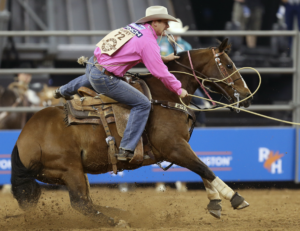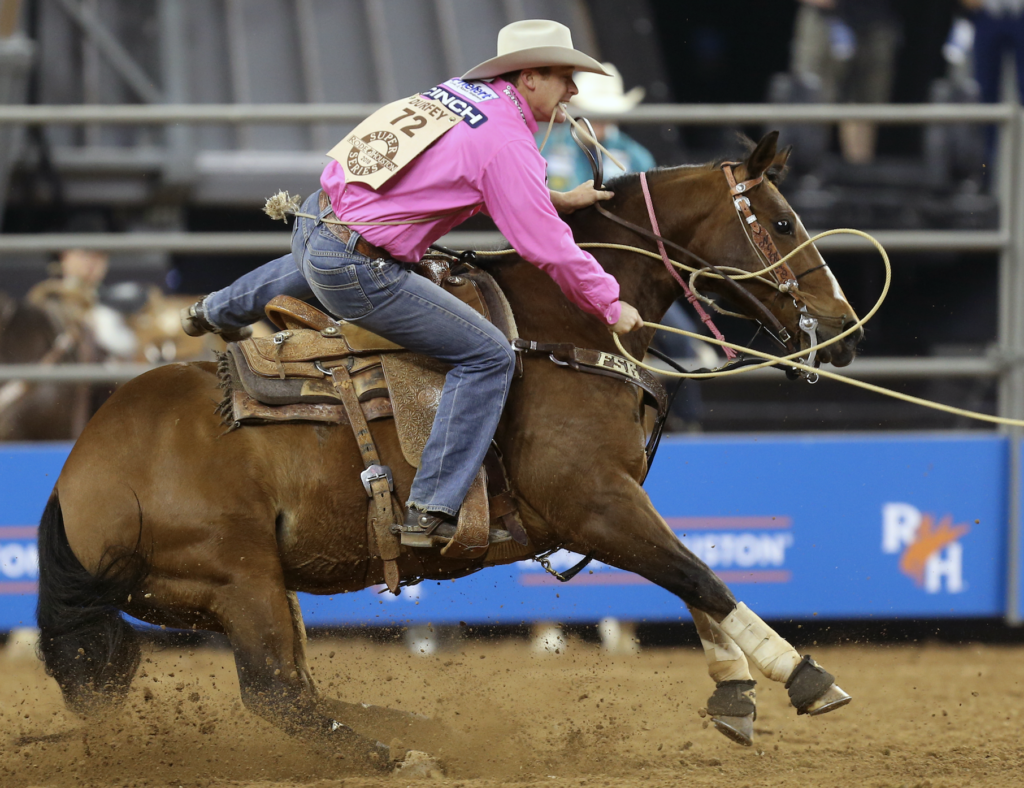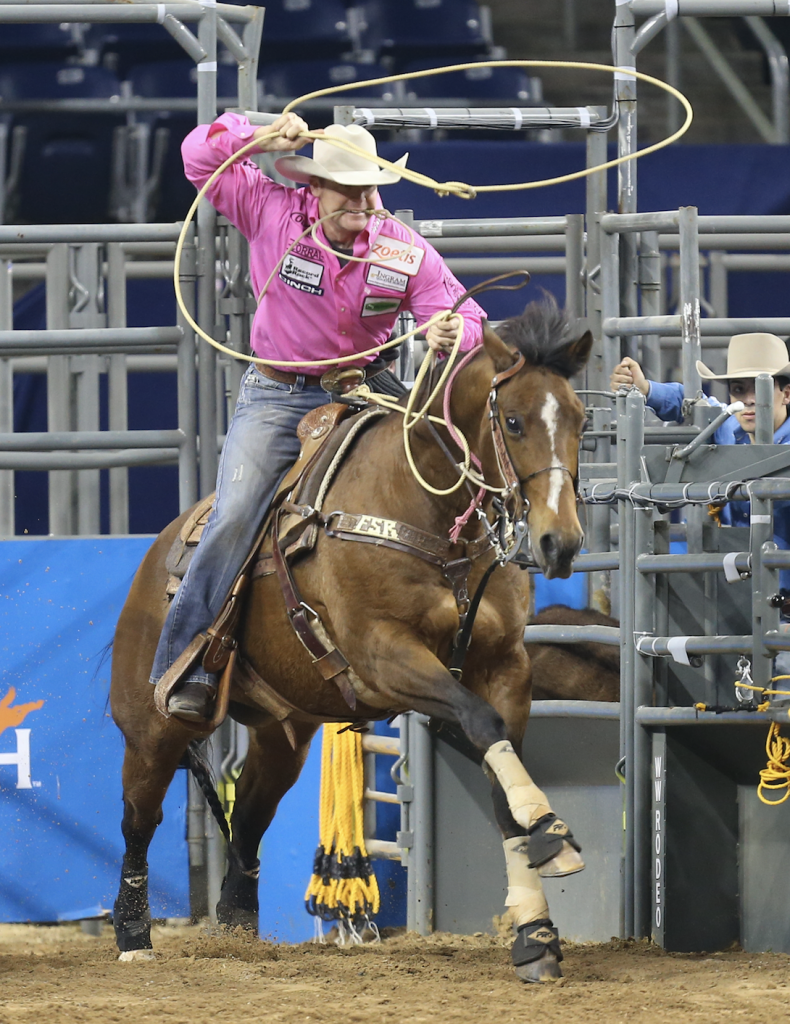This Pink Cowboy is Married to a Country Singer — and His Saddle: Malcolm Gladwell Has No Idea What It Takes to Be a True Rodeo Champion
BY Annie Gallay // 03.09.18Tyson Durfey took home the gold at RodeoHouston in 2016.
Each year, more than 300 cowboys and cowgirls compete in the Houston Livestock Show and Rodeo in both timed and rough stock events. Amid all the carnival rides, concerts, and deep fried anything you can imagine, it’s possible to overlook these athletes.
But cowboys and cowgirls make RodeoHouston what it is. These competitive athletes show their talent, skills and tenacity over three stunning weeks.
PaperCity sat down with a champion cowboy to learn more about what goes into competing at Houston’s Rodeo. Tie-down roper Tyson Durfey shares his insights on his event and what inspires him to do what he does so well.
It’s hard to miss Durfey out there in NRG Stadium. His speed, his precision, and even his shirt stick out. This cowboy sports a pink button down each and every time he takes the dirt.
“It’s just my way to raise awareness for breast cancer research. Not just breast cancer, but all forms of cancer,” Durfey tells PaperCity. “It’s affected me, my family and numerous friends. It was just a cause I felt like I wanted to get behind a long time ago. Ten years later, I’m still wearing a pink shirt.”
Durfey earned third place and won $1,000 for a time of 11.7 seconds on Monday night. The Savannah, Missouri native won big in 2016. At age 32, Durfey took home top prizes as RodeoHouston Champion and World Champion.
“Rodeo for me was a family thing,” Durfey says. His grandfather was on a rodeo committee in South Dakota in the late 1940s. His father started out training horses and became a bull rider and calf roper. Durfey’s father actually competed in Houston in the 1970s.
There was never any question of which event Durfey would dedicate his life to. “Well for me, my family is pretty much tie-down ropers. If you weren’t a tie-down roper, you were pretty much disowned,” he says. The same went for his two cowboy brothers.
The Art of Tie-Down Roping
Tie-down roping got its start in the old west on working ranches. Cowboys had to be quick on their feet — mentally and physically — to rope calves in need of medical attention.
Immobilizing calves evolved into a competition, cowboys besting one another at riding horses, swinging their ropes, and tying up the livestock. The requirements are no joke: you’ve got to be a good horseman and a fast sprinter. You’ve got to be both patient and quick, both experienced and intuitive.
The basis is trust and teamwork between the horse and rider. It takes about five years to make a good calf-roping horse, a seasoned one, Durfey says. All horses have different personalities, but that’s the average time for a horse to get accustomed to the lights, the crowd, the fireworks.
His horse, Nikko, helped him win both championships in 2016. “He is just a beautiful bay gelding with a great mindset and a great attitude,” Durfey adds. The two have worked together for three years. Nikko was previously worked by another roper who took him to rodeos all across America for years.
In tie-roping, the calf gets a head start as the cowboy rides out. As soon as the cowboy throws his loop and catches the calf, he jumps off, throws the calf down, which is called “flanking” and ties any of the three legs together. Timing is everything.
“It takes a lot of practice to get to the level where you can even compete in the Houston Rodeo,” Durfey says. “There’s a book by Malcolm Gladwell called The Outliers and it talks about how it takes 10,000 hours to be great at anything.”
But that standard is just not good enough if you want to be a world champion cowboy.
“Most world champions put in 20,000 hours of practice,” Durfey says. “I’ve been training every day of my life since I was four years old. That’s 30 years.”
When he was younger, he would set his alarm to 4:30 am, get himself out of bed and practice his flanking and tying technique, all before going to school. Once the bell rang, it was back to work until 10 at night. There’s no rest for the training.
“On the weekends… that’s just more time to grind,” Durfey laughs. But it’s no joke. For years, he trained 15 hours per day.
Now, Durfey has managed to shrink that time down. It’s better on his back, and better on his schedule.
“I have a little girl and family,” Durfey says. His wife, country singer Shea Fisher-Durfey, and his daughter Praise Royal Durphy “are the most important thing.” It takes work to balance family time with time on the road and competing.
The cowboy values family and his own ability to contribute. “Probably the thing that inspires me the most to do my job to the best of my ability is that there’s so many people who can’t do their jobs,” Durfey says.
He’s inspired by people (including cowboys) who have been injured, paralyzed and more, “people who don’t have the capacity to do what their heart wanted to do.” The reason he works hard is to do it for those who can’t.
He can do it and he’s at the top of his game. But not every day is easy. How does he pull it off on rough days?
“Really just telling yourself even when you don’t feel it in your heart that you’re good enough, tell yourself you’re good enough,” Durfey says. “Tell yourself so many times that you don’t believe anything other than that.”









_md.jpeg)






